
NPS Photo/Jonah Snead The outstanding biodiversity of the Gila National Forest and Wilderness provides for a remarkably varied bird fauna. Over 100 bird species are common to the area, and you might get lucky and experience a rare sighting. New Mexico is home to many seasonal and year-round birds, as well as many migratory birds. 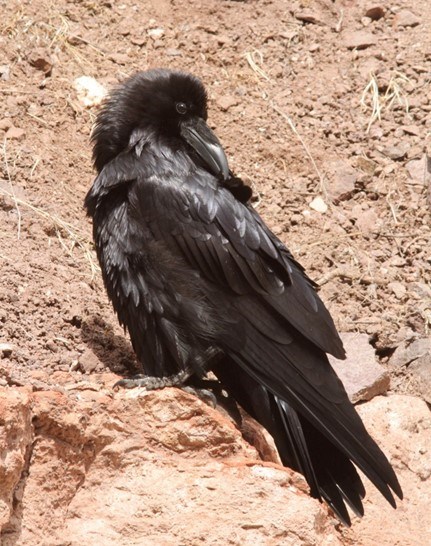
G.Warrick "Common" RavenFamily: CorvidsSize: 24 inches, wingspan 53 inches Habitat: Found in a variety of habitats, including mountains, deserts and coastal areas. About: A very large all-black bird, ravens are commonly seen flying high over the Gila National Forest and at the Gila Cliff Dwellings trailhead parking area. But whether they are common or Chihuahuan ravens remains a bit of a question. Based on habitat, the former seems more likely, since common ravens are more frequent in mountainous terrain. Chihuahuan ravens are more likely to be seen in open desert-like landscapes. But that is not entirely unlike the upper Gila River valley. More gregarious than the common raven, Chihuahuan ravens often congregate in groups of dozens to more than one hundred, much like crows. Both species have a large vocal repertoire that is similar enough to cause confusion. The common raven is larger (24 inches in length vs. 20), but that is hard to judge without a side-by-side comparison. The Chihuahuan raven has white under-feathers on the neck that can be seen on the rare occasion that a gust of wind blows the outer feathers apart; hence their former name, white-necked raven. The length of the bristles that extend from the base of the bill is proportionally longer in the Chihuahuan, but there is overlap between the two species, so that is not a useful field mark for many individual birds. Like all other corvids, ravens are extremely intelligent and playful. Ravens eat a very wide range of foods and have done well adjusting to the expansion of human settlement. At the trailhead parking area they search for anything edible (please don’t feed them) that might be in the back of an unsuspecting visitor’s pickup. And they won’t stop there. They have been known to enter vehicles through open doors and windows, and even unzip unattended bags in search of food. Beware! There is an ongoing discussion as to whether this is a common raven or a Chihuahuan raven. 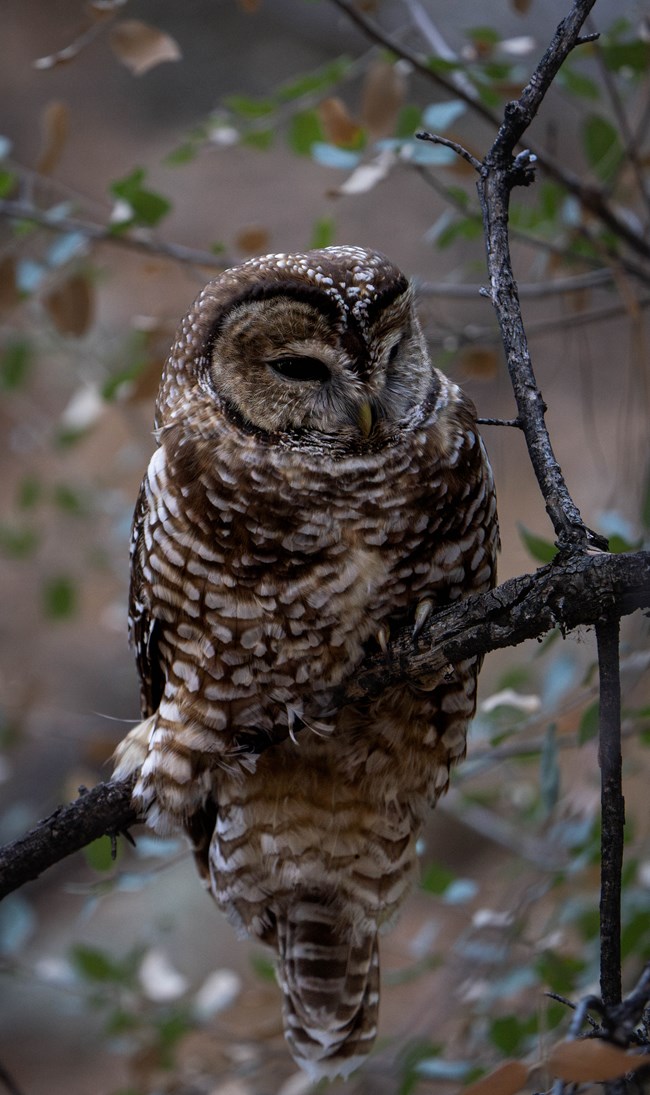
NPS Photo/Jonah Snead Mexican spotted owlFamily: True Owls (Strigidae)Size: 18 to 19 inches, wingspan 39 to 40 inches Habitat: Pine-oak and mixed conifer forests, particularly in steep canyons About: This relatively small owl is found in wooded areas throughout the Western United States. Here in the Southwest it is found in higher elevations in pine/fir/oak/juniper forests. The Spotted owl is particularly sensitive to high temperatures and as a consequence, tends to live and roost in steep sided canyons that are cooler than the nearby forested mesa tops. Its preference for cool temperatures also means it prefers complex, multistoried forests in order to scale up and down within the canopy to stay at the right temperature throughout the day. Spotted owls are carnivores that feed primarily on pack rats and flying squirrels. They eat other small mammals that they come across while hunting at night as well, swooping down to pluck prey from a branch or the ground then taking them to a high branch to eat. They will also store food in the crooks of branches, slowly walking away from the stashed prey as if creating a mental image of the location in their mind before flying off. Spotted owls generally mate for life. 1 to 4 eggs are laid in the spring and hatch within about one month. They fledge after about 35 days. The young stay near the nest for another 2 to 3 months and then leave the area in early fall. 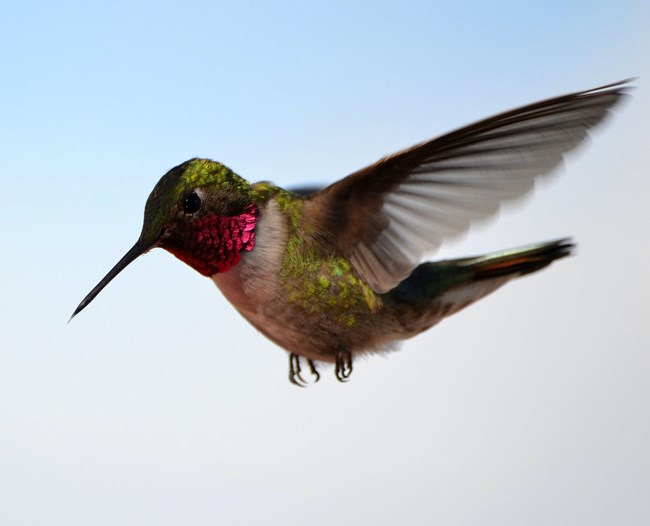
NPS Photo Broad-tailed hummingbirdFamily: HummingbirdsSize: 3 to 4 inches, wingspan 5.25 inches Habitat: Shrubby habitat near conifer forests and high elevation meadows About: The Broad-tailed hummingbird is a handsome hummingbird with an iridescent green back and white breast, with the males displaying a prominent iridescent magenta throat patch (in hummingbirds called a gorget). They look similar to the Anna’s hummingbird, but the Broad-tailed hummingbird has a green rather than magenta head. They feed on nectar from plants and also eat a lot of tiny insects, picked from leaves, snatched midair, or picked out of spider webs. Male Broad-tailed hummingbirds can be seen during the spring and summer months performing an impressive courtship dance for the females in which they fly high up in the air, sometimes over one hundred feet, and come zooming down toward the female, their wings making a loud buzzing sound, pulling out of their dive right in front of the perched female. They will use this dive to chase off rival males and even other animals (including humans) that get too close to food sources! Once they mate, the females take over rearing duties. The female builds a nest made mostly out of spider webs that she forms around her body. She then camouflages the nest by sticking bits of lichen, moss, bark, and plant material to the outside. She lays 2 tiny eggs that hatch in 16 to 19 days and fledge in another 21 to 26 days. 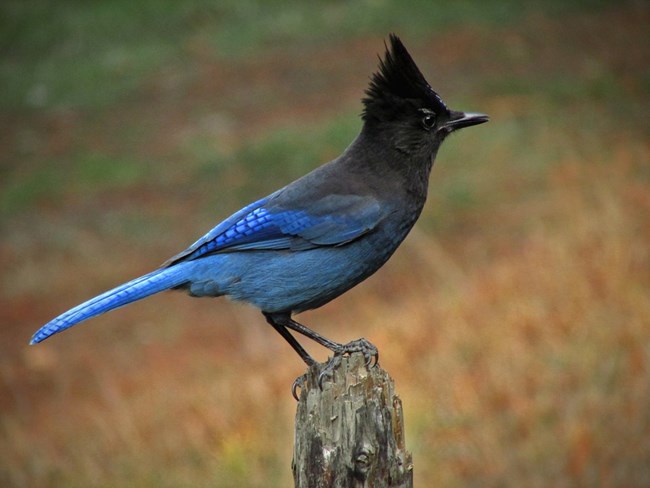
NPS Photo Steller's JayFamily: CorvidsSize: 11 to 14 inches, wingspan 17 to 18 inches Habitat: Coniferous forests, particularly between 3,000- and 10,000-feet elevation About: This beautiful and conspicuous jay is found in evergreen forests from the Rocky Mountains west to the Pacific Ocean. While there are at least 16 sub-species of Steller’s jay, some of which look quite different from each other, all of them have a black crest making them easy to tell apart from other jays. The Steller’s jay is closely related to the Eastern blue jay and in parts of the Mid-western United States hybridize with it. Steller’s jays are omnivores and opportunists feeding on insects, nuts, berries, small animals, eggs, unguarded picnics, and food thrown away by humans. They are incredibly intelligent with great spatial memories. They often cache food in cracks and crevices found in trees but unlike other birds tend to remember where nearly every cache is. They are also very vocal with the ability to mimic other birds. They will often sound the alarm when a predator is near and mob it along with other species. Steller’s jays nest on the branches of conifer trees, near the trunk. Usually the 10 to 15 inch diameter nest is found near the top of trees, but they can be found anywhere above 3 feet from the ground. These and blue jays are the only Western Hemisphere jays to use mud in the construction of their nests. They lay 2 to 6 eggs that hatch in about 16 days. The young fledge about 16 days after hatching. 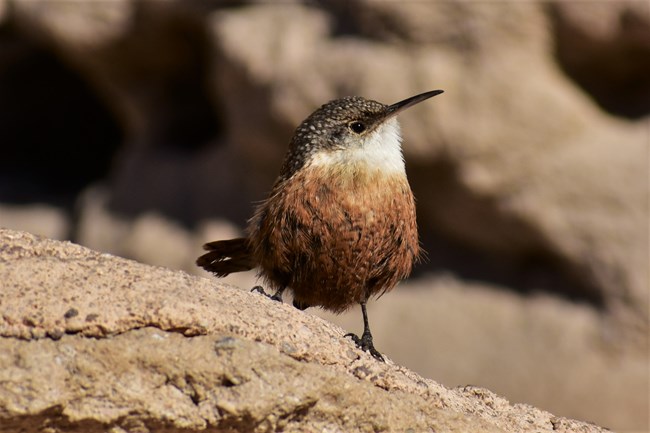
NPS Photo Canyon WrenFamily: WrensSize: Body 4.5 to 6.5 inches, wingspan 7 to 8 inches Habitat: Cliffs, steep sided canyons, rocky outcrops and boulder piles in arid regions About: This handsome bird is a familiar companion to anyone who has ventured into the canyon country of the American southwest. Its call, a loud, sweet cascade of whistles that echo off canyon walls, is one of the most distinctive and beautiful bird calls heard North America. These small birds blend in with their surroundings, but if you catch a glimpse, they have a rich cinnamon brown body with dark brown speckles and a stark white throat. Canyon wrens are active hunters that eat mostly insects and spiders that they catch on the rocks, snag from spider webs, steal from wasps’ nests, and sometimes pursue in the air. They can often be seen skittering across steep open spaces looking for prey on the rocks. These wrens nest in sheltered crevices in a small nest made of twigs and grasses held together and lined with lichens, feathers and spider webs. They have 4 to 6 eggs which hatch within 12 to 18 days with the female incubating the eggs and the male feeding her through this period. The young are able to forage with their parents after about 10 days of hatching. Canyon wrens are thought to get all of the water they need from their food without having to drink directly from a water source – a handy adaptation for this desert dwelling bird! They also seem to have an ongoing feud with white-throated swifts who nest in the same canyon walls that canyon wrens do. In Arizona swifts have been observed divebombing canyon wrens when they hear the distinctive song. 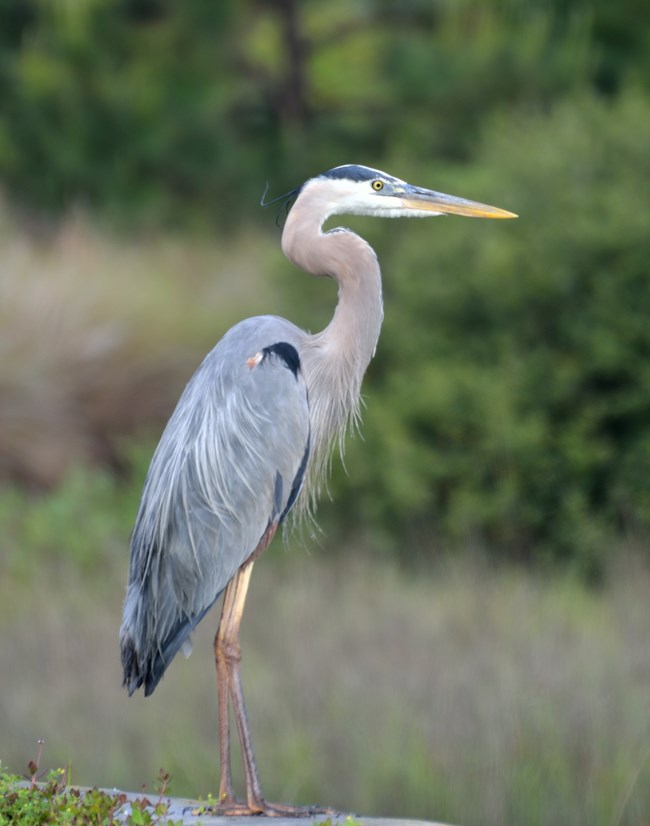
Great blue heronFamily: Herons, egrets, and kinSize: 38 to 54 inches, wingspan 74 to 89 inches Habitat: Feeds near or in fresh and salt water. Nests usually within 3 miles of feeding areas. About: The majestic Great blue heron can be seen through much of the United States quietly stalking fish in shallow waterways or flying with slow, deep wingbeats and curved neck over the landscape. This largest of North American herons is a skilled fisher that will also opportunistically feed on frogs, small mammals, large insects, and other birds. For most of the year the Great blue heron is solitary – guarding its feeding territory from other herons, other aquatic birds, and even humans. If a heron perceives a threat to its territory it will extend its neck, throwing its head back and stretching out its wings while calling out a loud “KRAAK!” sound. From a bird that often stands over 4 feet tall, this can be quite an intimidating display! During breeding season these usually solitary and territorial birds gather in great rookeries, sometimes containing hundreds of pairs. These rookeries are often high up in tall trees where they make large nests up to 4 feet across and 3.5 feet deep. The sight of large groups of these giant birds on the slim branches high in the treetops is one of the strangest in nature! 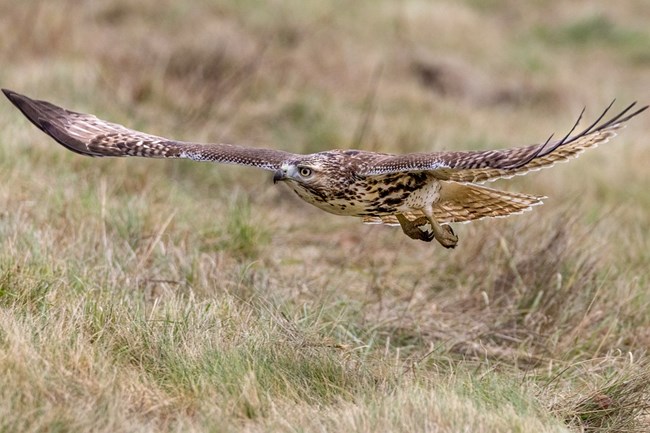
Red-tailed HawkFamily: RaptorsSize: 17 to 24 inches, wingspan 44 to 53 inches Habitat: Very widespread in North America, found primarily in open areas About: The Red-tailed hawk is the largest of North American hawks as well as one of the most common and recognizable. The large size, broad wings, and distinctive red tail can be seen circling over open areas from Alaska to central Mexico and from the Pacific Coast to the Atlantic Coast. They are also often seen perching on telephone or light poles looking for movement in the grass below. Though they are distinctive for their large size, Red-tailed hawks rarely weigh more than 3 pounds, testament to how well adapted to life on the wing they are. The Red-tailed hawk feeds primarily on small rodents such as mice, but able to catch prey as large as cottontail rabbits. They also eat small birds and reptiles when given the chance. They hunt by scanning the ground with their excellent eyesight either flying high above grasslands or perched high on a telephone pole, light pole, or tree overlooking grassy areas. Once prey is spotted, they swoop down to surprise it from above. These large hawks make equally large nests often reaching 3 feet across and sometimes as much as 6.5 feet tall! These nests are usually constructed at the crown of large trees with a commanding view of the landscape below. Sometimes they will nest on cliff edges or even window ledges and billboards if they are in the right location. The nest is built of dry sticks and lined with bark strips, fresh vegetation, and dry grass. The female lays 1 to 5 eggs that hatch in about a month and the young fledge around 45 days later.
Below you will find a list of common and not so common birds that have been spotted in the monument arranged by family and common names.
To explore current and past bird sightings in the area, check eBird at: https://ebird.org/hotspot/L589670
| ||
Last updated: April 24, 2025
